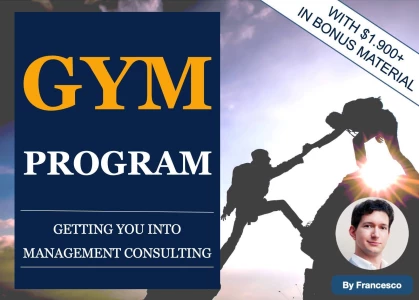Hi, I have been invited to BCG final interview rounds and found out that there will be a written case interview. How can I best prepare for this? The interview is in 2 weeks.
Thanks!
Hi, I have been invited to BCG final interview rounds and found out that there will be a written case interview. How can I best prepare for this? The interview is in 2 weeks.
Thanks!


Hi Anonymous,
I would recommend you to focus on 5 areas to crack a written case; I have reported them below with some suggestions on how to prepare for each of them
1. Learn how to define a plan of action and stick to that
The first thing you should do in a written case is to define a plan and allocate in the best possible way your time. Assuming 60 minutes for the analysis, a good approach would include:
You should then practice to stick to the time allocated, in order to maximize your final performance.
2. Practice graph interpretation
You will normally have to analyse graphs in a written case. The best way to practice is to take graphs from online resources and use a timer to test in how much time you can understand the key message. McKinsey PST graphs could be a good practice for that.
3. Work on quick reading and quick understanding of key information
You will not have time to read and prioritize everything, so you have to understand where to focus. The ideal way to practice is to use long cases such as HBS ones, and practice on reducing the time needed to absorb the key information that can answer a defined question. Quick reading techniques could also help.
4. Practice quick math
You will normally have math to do in a written case. GMAT and McKinsey PST math should work well to prepare on this.
5. Learn how to communicate your slides/answers (if required)
You may have to present your findings at the end of the case. I would apply the same structures of final sum up in a live interview case, that is:
As you will not be able to double check hypothesis with the interviewer as in the live case before the presentation, it could make sense to clearly state when you are making hypotheses and that you will have to verify them with further analysis.
Hope this helps,
Francesco
I have not done a BCG-specific written case, so take everything I say with a grain of salt.
Generally for written cases where a lot of information is presented to you up-front, it is important to not let the data guide your structure. What I mean by that is you should set up your problem solving structure and hypotheses before looking at the data in detail.
There is three problems with letting the data dictate your structure:
My recommendation would be to skim the data they provide you with after reading the objective, then setting up your issue tree/hypotheses. Use the provided data only to validate/dismiss your hypotheses, make assumptions or ask the interviewer when there is no data included to validate/dismiss a specific hypothesis.
Hope this helps and good luck!

Hi,
Here I've uploaded some written case samples (incl BCG)
https://www.dropbox.com/sh/zor4m49eyx5qxal/AABeUN6mtiGkWhEklRjszX2Oa?dl=0
The best way to prepare is the following:
Good luck!

Hi anonymous A,
Congrats on getting to second round. Regarding the written case, BCG is looking for the same qualities as in the oral one. Even though you will have more time to prepare, preparing the slides will be time consuming: it comes down to time management. Assuming 3 hours for the analysis, I would allocate:
If you can crack a regular case, you should be able to crack the written one as well.
I have added here an example of a written case from BCG.
https://www.dropbox.com/sh/tqrn34hddrpg696/AABCpypFAmyaWEFSCFGIDpafa?dl=0
Also, you will find plenty of additional tips in the Q&A section here on Preploung.
Good luck :)
Jacopo

Hi there,
in addition to the other comments, find below some example cases that are also suitable for the written case format:
Best
I replied to the message under the Bain question.
I've done a 2nd round written case. Not Bain... there are some differences but the key points are the same.
Just like any case, remember to:
a) Answer the questions asked
b) Ensure you communicate your methodical approach/framework/decision criteria
c) Continually update where you're going as new information comes out (hypothesis testing etc)
The biggest difference is that, because you're alone in a room, you don't get a chance to ask clarifying questions.
Therefore you have to make assumptions.
Its highly likely that things that a clarifying question could be used to answer in a regular case (what are the clients, specific goals? what are their resources? can you tell me more about their product? etc) will *NOT* be answered in the case prompt. Therefor you have to fill in that gap or you can't do your job.
This shouldn't be scary, but it is an important thing to consider early on - some people, due to having industry knowledge, or simply "good business instinct" - don't take the time to understand the assumptions they make to start a case. During regular cases the ability to ask clarifying questions might allow them to get aroudn this, but without that opportunity... its very important to state your assumptions up front. You can (and should) make sure to highlight how risky/likely these assumptions are and the upside/downside if thy are not true. But so long as your assumptions are identified and reasonable, there is no reason to stress about this too much.
The other thing to note is that - especially in AT Kearney, but often in other written cases as well - the 'opportunity', or key to the case, lies in unknowns and intangibles. These intangiables include assumptions, but just as important are things like... If you have several different exhibits, are they all from the same sources? Are they apples to apples/in the same units, and... with some basic assumptions... can you use one to infer things about the other?
These intangibles are really an opportunity to show things like initiative and ability to sell your ideas, which are things a regular case can't really do. And as you know. these are very important fundamental aspects to a successful consultant.
Lastly, on a practical level, you're judged on the same thigns you are for a regular case. Confidence, conciseness, good synthesis-making ability, sticking to the topic, client friendly, etc.
I keep my written cases close to the vest, because... well, I really like the firms involved and would the cases I have aren't widely disseminated. I plan to interview there again at my first opportunity, and would hate But if you message me I'll help as much as I can.
Ben

Hi Anonymous,
quoting a previous answer, I would recommend to focus on 5 areas to crack a written case; I have reported them below with some suggestions on how to prepare for each of them
1. Learn how to define a plan of action and stick to that
The first thing you should do in a written case is to define a plan and allocate in the best possible way your time. I saw Jacopo already quoted my previous answer, I agree that assuming 3h (a bit unusual - normally you have 2h for the BCG written case) for the analysis with 20-30 pages, a good approach would include:
You should then practice to stick to the time allocated, in order to maximize your final performance.
2. Practice graph interpretation
You will normally have to analyse graphs in a written case. The best way to practice is to take graphs from online resources and use a timer to test in how much time you can understand the key message. McKinsey PST graphs could be a good practice for that.
3. Work on quick reading and quick understanding of key information
You will not have time to read and prioritize everything, so you have to understand where to focus. The ideal way to practice is to use long cases such as HBS ones, and practice on reducing the time needed to absorb the key information that can answer a defined question. Quick reading techniques could also help.
4. Practice quick math
You will normally have math to do in a written case. GMAT and McKinsey PST math should work well to prepare on this.
5. Learn how to communicate your slides
I would apply the same structures of final sum up in a live interview case, that is:
As you will not be able to double check hypothesis with the interviewer as in the live case before the presentation, it could make sense to clearly state when you are making hypotheses and that you will have to verify them with further analysis.
In terms of slides, I would recommend working on:
#1: structure the order of the slides
Normally the structure for a 5-slide presentation is the following:
#2: structure the content of each slide
There are three basic components for slides:
Many people structure the title as the mere description of what the chart is telling. A great title, instead tells the implication of the graph. Eg say the graph is showing a cost structure for a division. A bad title would be: Cost structure from 2005 to 2015. A good title would be: Cost structure of Division XYZ is not sustainable”. A great title would be Cost structure of Division XYZ is not sustainable due to ABC, assuming you have insides on the cause. The rule of thumb for the title is that if you read all the titles of the slides together you should get a clear idea of what is going on.
# 3: present the slides
When you present, I would suggest the following steps for each slide:
Hope this helps,
Francesco

Hi Anonymous,
the answer would depend on whether you have also to prepare the slides or not. The usual steps to follow in a written case are:
1. Learn how to define a plan of action and stick to that
2. Practice graph interpretation
3. Work on quick reading and quick understanding of key information
4. Practice quick math
5. Learn how to communicate your slides/answers (if required)
At the following link you can find a detailed description of each of these areas:
https://www.preplounge.com/en/consulting-forum/hi-guys-who-has-experience-with-doing-a-bcg-written-case-any-ideas-on-how-to-prepare-for-this-suggestionskey-takeawaysexamples-are-more-than-welcome-thanks-a-lot-for-your-help-569
If you have also to prepare slides I would also recommend to work on
#1: structure the slides
There are three basic components for slides:
Many people structure the title as the mere description of what the chart is telling. A great title, instead tells the implication of the graph. Eg say the graph is showing a cost structure for a division. A bad title would be: Cost structure from 2005 to 2015. A good title would be: Cost structure of Division XYZ is not sustainable”. A great title would be Cost structure of Division XYZ is not sustainable due to ABC, assuming you have insides on the cause. The rule of thumb for the title is that if you read all the titles of the slides together you should get a clear idea of what is going on.
# 2: present the slides
When you present, I would suggest the following steps for each slide:
Best,
Francesco

Hi,
I've uploaded some samples here:
https://www.dropbox.com/sh/zor4m49eyx5qxal/AABeUN6mtiGkWhEklRjszX2Oa?dl=0
(ask me for a password)
The best way to prepare is the following:
The appropriate structure for BCG written case is:
Slide 1: Context, Objective, Recommendations
Slide 2-4: Analysis (Usually 1 slide with a table, 1 slide with graphs and 1 slide with pros and cons)
Slide 5: Next steps or risks & mitigation
Good luck!

Hi A,
I have pleanty of written cases - feel free to reach out.
Best,
André
It'll be quite similar to an oral case, but you might be expected to fill in some graphs, organise some slights and write a summary before presenting to someone typically at a level around Manager.
I'd make the following recommendations: - Be very aware of time. Do you have enough time to do calculations to one decimal place, or will you need to estimate?
- Make sure you've thought through how you are going to communicate the story. Do you have the slides with good context, an answer and then a logical proof behind it?
- Sounds a simple one, but write clearly and don't make a mess. Draft up a chart on scrap paper before editing a handout if you're not sure, for example
Good luck!
Hi Anonymous A,
thanks for asking your question on our Consulting Q&A :)
If you haven’t already, you might want to check out this Q&A: Bain Written Case
It is about the written case with Bain, but might contain some useful information for the BCG written case, as well!
Hope this helps,
Astrid
PrepLounge Community Management

Preparing for a written case is no different than an oral case. Repetition is the key. I recommend (for cost effectiveness reasons) that you figure out what your key weaknesses are. There are 3 fundamental aspects that the interviewer is judging on both an oral and written case presentation:
You need to be distinctive on either Analytical, Conceptual or something else. Quant will NOT get it. Send me a message if you need more details free of charge. Or, anyone else.

Hi,
I've uploaded some samples here:
https://www.dropbox.com/sh/zor4m49eyx5qxal/AABeUN6mtiGkWhEklRjszX2Oa?dl=0
(ask me for a password)
The best way to prepare is the following:
The appropriate structure for BCG written case is:
Slide 1: Context, Objective, Recommendations
Slide 2-4: Analysis (Usually 1 slide with a table, 1 slide with graphs and 1 slide with pros and cons)
Slide 5: Next steps or risks & mitigation
Good luck!


I can share a few examples and resources for this.
For anybody who is looking into the topic, feel free to reach out.
Best,
Cristian
I had written case in first round of BCG. The biggest challenge was to separate important information from red herring, as they are giving to candidates a folder with lots of documents - some of them are relevant, but most - are not.
If you have the same format, then understand the problem, draw you issue tree, and collect the informarion based on specific needs. You'll be out of time if you try to read and analyze everyting.
Than candididate needs to do extensive calculations (try to find the shortcuts, otheriwse you'll be out of time).
Finally candidate needs to draw a couple of slides and show off communicatioin skills to deliver solution to interviewer.
Good luck!

Hi Rajat,
I have answered a similar question a few days ago. You can find it here: https://www.preplounge.com/en/consulting-forum/bcg-paris-round-23-advice-for-written-case-1063#a2050
My recommendation is to prepare on practice material by timing yourself (to make sure you can cover all the questions within the allowed time).
You will find a couple of written cases here:
https://www.dropbox.com/sh/tqrn34hddrpg696/AABCpypFAmyaWEFSCFGIDpafa?dl=0
You can probably find some additional preparation material on this forum as well.
Once you have finished the exercise, I highly recommend you to share the outcome with a peer (even better if you know an experienced consultant) in order to get his feedback and exchange/get challenged on the content.
Good luck,
Jacopo

Hi,
Thanks Jacopo for using the written case samples I've uploaded before. Here is the correct link:
https://www.dropbox.com/sh/zor4m49eyx5qxal/AABeUN6mtiGkWhEklRjszX2Oa?dl=0
The best way to prepare is the following:
The best structure for BCG written case is:
Slide 1: Context, Objective, Recommendations
Slide 2-4: Analysis (Usually 1 slide with a table, 1 slide with graphs and 1 slide with pros and cons)
Slide 5: Next steps or risks & mitigation
Good luck!

Hi Rajat,
The usual steps to follow in a written case are:
1. Learn how to define a plan of action and stick to that
2. Practice graph interpretation
3. Work on quick reading and quick understanding of key information
4. Practice quick math
5. Learn how to communicate your slides/answers (if required)
At the following link you can find a detailed description of each of these areas:
https://www.preplounge.com/en/consulting-forum/hi-guys-who-has-experience-with-doing-a-bcg-written-case-any-ideas-on-how-to-prepare-for-this-suggestionskey-takeawaysexamples-are-more-than-welcome-thanks-a-lot-for-your-help-569
If you have also to prepare slides, quoting a previous answer I would also recommend to work on
#1: structure the order of the slides
Normally the structure for a 5-slide presentation is the following:
#2: structure the content of each slide
There are three basic components for slides:
Many people structure the title as the mere description of what the chart is telling. A great title, instead tells the implication of the graph. Eg say the graph is showing a cost structure for a division. A bad title would be: Cost structure from 2005 to 2015. A good title would be: Cost structure of Division XYZ is not sustainable”. A great title would be Cost structure of Division XYZ is not sustainable due to ABC, assuming you have insides on the cause. The rule of thumb for the title is that if you read all the titles of the slides together you should get a clear idea of what is going on.
# 3: present the slides
When you present, I would suggest the following steps for each slide:
Hope this helps,
Francesco

Hi Anonymous,
I would recommend to focus on 5 areas to crack a presentation/written case; I have reported them below with some suggestions on how to prepare for each of them
1. Learn how to define a plan of action and stick to that
The first thing you should do in a written case is to define a plan and allocate in the best possible way your time. Assuming 120 minutes for the analysis, a good approach would include:
You should then practice to stick to the time allocated, in order to maximize your final performance.
2. Practice graph interpretation
You will normally have to analyse graphs in a written case. The best way to practice is to take graphs from online resources and use a timer to test in how much time you can understand the key message. McKinsey PST graphs could be a good practice for that.
3. Work on quick reading and quick understanding of key information
You will not have time to read and prioritize everything, so you have to understand where to focus. The ideal way to practice is to use long cases such as HBS ones, and practice on reducing the time needed to absorb the key information that can answer a defined question. You should also be able to find some free written test examples online. Quick reading techniques could also help.
4. Practice quick math
You will normally have math to do in a written case. GMAT and McKinsey PST math should work well to prepare on this.
5. Learn how to communicate your slides/answers
You may have to present your findings at the end of the case. I would apply the same structures of final sum up in a live interview case, that is:
As you will not be able to double check hypothesis with the interviewer as in the live case before the presentation, it could make sense to clearly state when you are making hypotheses and that you will have to verify them with further analysis.
When you have to prepare slides, quoting a previous answer I would also recommend to work on:
1) Structure the order of the slides
Normally the structure for a 5-slide presentation is the following:
2) Structure the content of each slide
There are three basic components for slides:
Many people structure the title as the mere description of what the chart is telling. A great title, instead tells the implication of the graph. Eg say the graph is showing a cost structure for a division. A bad title would be: Cost structure from 2005 to 2015. A good title would be: Cost structure of Division XYZ is not sustainable”. A great title would be Cost structure of Division XYZ is not sustainable due to ABC, assuming you have insides on the cause. The rule of thumb for the title is that if you read all the titles of the slides together you should get a clear idea of what is going on.
3) Present the slides
When you present, I would suggest the following steps for each slide:
Hope this helps,
Francesco

Hi,
I had some candidates who got the classic BCG written case as one of the interviews in the final round. I still don't know what's the trigger for this, but I think some offices just practice it. The case was exactly the same as the classic BCG written case. Even if it is a bit different in structure, I would recommend preparing in the same way.
I've uploaded some samples here:
https://www.dropbox.com/sh/zor4m49eyx5qxal/AABeUN6mtiGkWhEklRjszX2Oa?dl=0
(ask me for a password)
The best way to prepare is the following:
The appropriate structure for BCG written case is:
Slide 1: Context, Objective, Recommendations
Slide 2-4: Analysis (Usually 1 slide with a table, 1 slide with graphs and 1 slide with pros and cons)
Slide 5: Next steps or risks & mitigation
Good luck!

Hi Anonymous,
the general tips for a written case are still valid for the new format. Specifically you can prepare working on the following:
1. Learn how to define a plan of action and stick to that
2. Practice graph interpretation
3. Work on quick reading and quick understanding of key information
4. Practice quick math
5. Learn how to communicate your answers
Below you can find some details
1. Learn how to define a plan of action and stick to that
The first thing you should do in a written case is to define a plan and allocate in the best possible way your time. If you have 45 minutes for the analysis, a good approach would include:
You should then practice to stick to the time allocated, in order to maximize your final performance.
2. Practice graph interpretation
You normally have to analyse graphs in a written case. The best way to practice is to take graphs from online resources and use a timer to test in how much time you can understand the key message. McKinsey PST graphs could be a good practice for that.
3. Work on quick reading and quick understanding of key information
You will not have time to read and prioritize everything, so you have to understand where to focus. The ideal way to practice is to use long cases such as HBS ones, and practice on reducing the time needed to absorb the key information that can answer a defined question. Quick reading techniques could also help.
4. Practice quick math
You normally have math to do in a written case. GMAT and McKinsey PST math should work well to prepare on this.
5. Learn how to communicate your answers
I would apply here the same structures of final sum up in a live interview case, that is:
As you will not be able to double check hypothesis with the interviewer as in the live case before presenting, it could make sense to clearly state when you are making hypotheses and that you will have to verify them with further analysis.
Best,
Francesco

Hello,
The BCG written case usually a packe of 20-30 slides that you need to analyse to answer questions using 4-5 slides and present them to your interviewer.
In order to crack the interview you should consider the following points:
You can find some good examples of written cases online, but I could forward you what I have. Contact me if you are interested.
Hope it helps,
Luca

Hi,
if helpful, I have a couple of well done written cases, feel free to text me for sharing.
Best,
Antonello

Hi,
case preparation will be the classical one with 2 additional points to focus on:
I have a couple of well done written cases, feel free to text me for sharing.
Best,
Antonello

Hello!
Agree wtih Antonello, the competencies that are tested in these "written czases" are basically the same. The key part is the ability to manage your time and to handle the large amount of information that you have, and organize it in a 80-20 way.
You can find examples on the website of tMBBs.
Hope it helps!
Cheers,
Clara

Hi,
I've uploaded some samples here:
https://www.dropbox.com/sh/zor4m49eyx5qxal/AABeUN6mtiGkWhEklRjszX2Oa?dl=0
(message me for a password)
The best way to prepare is the following:
The appropriate structure for BCG written case is:
Slide 1: Context, Objective, Recommendations
Slide 2-4: Analysis (Usually 1 slide with a table, 1 slide with graphs and 1 slide with pros and cons)
Slide 5: Next steps or risks & mitigation
Good luck!

Hi A,
I have pleanty of written cases - feel free to reach out.
Best,
André

Bain and BCG, but also ATK for example... a number of firms do this actually. At a high level, it is the same kind of preparation that you'd do for a case; in other words, your skills will transfer to a large extent.
There are differences as well obviously. For one, you need to really track your time in a written case; I suggest coming in with a pre-defined plan such as "15 minutes to understand the question / data; 5 minutes to prepare my framework; 15 minutes to create the story; 15 minutes to draft the slides / write the answer; 10 minutes to review the work and prepare the oral presentation"
At least in my experience, there is no direct, significant interview input. You are just basically on your own, with too much data to absorb and not enough time. Very applicable to the real world :)
I know that Victor Cheng has some advice (and probably an example) on his page - you might want to check that out. Cheers
Thanks a lot for the pointers.
Hey - Thanks for the question! How did the written case go? Do you have any insights you could share?

Hello!
See this post > https://www.preplounge.com/en/consulting-forum/written-case-5638
It´s exactly the same u are asking.
Hope it helps!
Cheers,
Clara

Hello!
Congrats for moving to final round!
As it has been outlined, its very similar, but :
If you are interested in deepening your knowledge and preparation on the FIT part, the "Integrated FIT guide for MBB" has been recently published in PrepLounge´s shop (https://www.preplounge.com/en/shop/tests-2/integrated-fit-guide-for-mbb-34)
It provides an end-to-end preparation for all three MBB interviews, tackling each firms particularities and combining key concepts review and a hands-on methodology. Following the book, the candidate will prepare his/her stories by practicing with over 50 real questions and leveraging special frameworks and worksheets that guide step-by-step, developed by the author and her experience as a Master in Management professor and coach. Finally, as further guidance, the guide encompasses over 20 examples from real candidates.
Furthermore, you can find 3 free cases in the PrepL case regarding FIT preparation:
- Intro and CV questions > https://www.preplounge.com/en/management-consulting-cases/fit-interview/intermediate/introduction-and-cv-questions-fit-interview-preparation-200
- Motivational questions > https://www.preplounge.com/en/management-consulting-cases/fit-interview/intermediate/motivational-questions-fit-interview-preparation-201
- Behavioural questions (ENTREPRENEURIAL DRIVE) >https://www.preplounge.com/en/management-consulting-cases/fit-interview/intermediate/behavioral-questions-entrepreneurial-drive-fit-interview-preparation-211
Feel free to PM me for disccount codes for the Integrated FIT Guide, since we still have some left from the launch!













